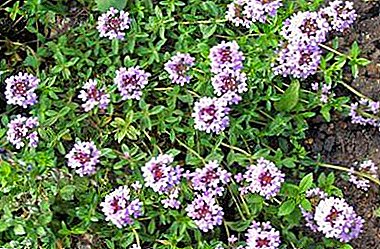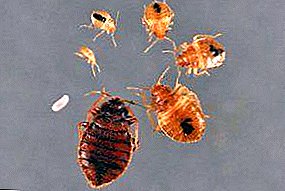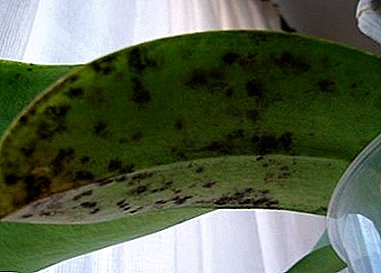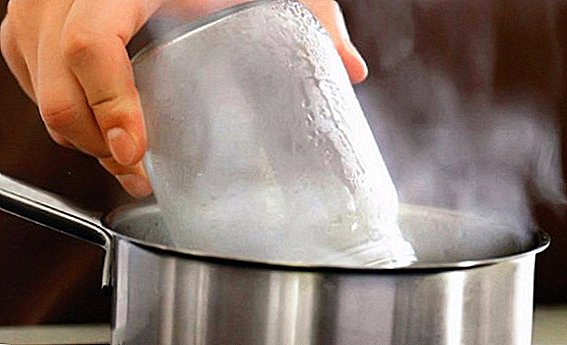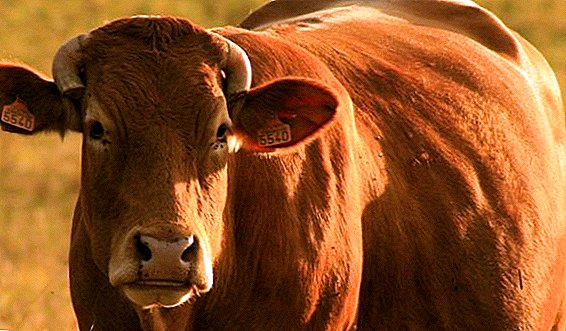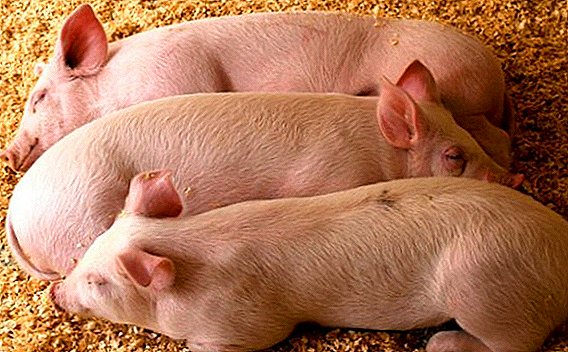 The most popular pet - a pig - with inadequate care can suffer from many diseases, most of which are similar to human ones and can be transmitted through meat and offal. In this article we will consider the diseases of pigs, their treatment and preventive measures.
The most popular pet - a pig - with inadequate care can suffer from many diseases, most of which are similar to human ones and can be transmitted through meat and offal. In this article we will consider the diseases of pigs, their treatment and preventive measures.
Parasitic (invasive) diseases
Pigs can suffer from both internal and external parasites. More than 30 species of worms are able to negate all the concerns of employees of pig farms. External diseases are no less dangerous - everyone now knows swine flu, and less dangerous diseases can bring many problems to the pig and its owners.

Internal parasites (worms)
Worms and worms are practically companions of pigs, since their owners rather feed the animal for weight gain and a quick sale. The main parasites of the pigs are intestinal roundworms and tapeworms (better known as tapeworm).
Check out also the features of the appearance of pig breeds.
Roundworms (roundworm)
Nematode Ascaris suum is located in the small intestine, entering the body of the animal when eating contaminated food. This usually happens when pasturing pigs or feeding on products of unknown shelf life and origin. Under such conditions, the absorption of ascaris eggs is possible, followed by their reproduction in the intestine after two months. As pigs age, the danger of roundworm invasion decreases.

Symptoms
External signs of the disease are most developed in piglets up to 8 months of age, who experience exhaustion and anemia. A significant amount of ascaris can cause the death of animals and adults. In the event of intoxication, a rash, often diagnosed as allergic, is possible, and valuable treatment time is missed.
Important! Farting pigs are not funny at all: flatulence may be a consequence of blockage of intestines with roundworms. Such a condition can lead to the death of the animal.
Treatment
You can withdraw or destroy roundworm using the following drugs:
- piperazine salt;
- sodium fluoride;
- Hygromycin B.

Prevention
In order to avoid helminthization of pigs, you can carry out preventive measures using the above tools, adding them to the morning and evening feeding. It is necessary to exclude the contact of the herd of the pig farm or household with the outside world.
Important! Newly arrived animals, before being added to the herd, undergo a koproskopy - their excrement is examined for all infectious diseases.
Tapeworms
This type of parasite is found in the body of the pig mainly in the form of larvae, which are eaten by those who consume the meat of an infected animal (in most cases it is a human being). The most common worms are pork tapeworm, taenia hydatigena and worms of the echinococcus subspecies. For all these worms, the pig is only an intermediate carrier; they enter its body when they eat dog, fox, or wolf feces.

Symptoms
Depending on which organ is infected, infection with parasites can manifest as dyspnea, heavy breathing and coughing, disorders of the gastrointestinal tract, traumatic hepatitis, and bleeding to the liver.
Learn more about the breeding of landrace, duroc, pigren, Hungarian mangalitsa, Vietnamese vislobryukhaya, karmal, red-belted, downy mangalitsa, Mirgorodskaya pig, large white pig.
Treatment
It is possible to cure a pig with specialized anthelmintic drugs: "Fenbendazol", "Febantel", "Albendazole", etc. Such drugs are destructive not only for adult worms, but also for its larvae. Treatment should be carried out in strict accordance with the instructions to the drug, taking into account the results of laboratory tests and resistance to the treatment of certain types of worms.

Prevention
The best method of prevention is a carefully prepared area for grazing, where using technical means (an obstacle, scaring equipment for animals, etc.), it is possible to exclude the contact of the herd with representatives of the wild fauna.
External parasites
Given the lifestyle of a pig, it is prone to diseases not only from internal parasites, but also from external ones. Especially priests lice, miase and scabies, irritation of the skin from which the animal can not calm down, due to the structure of his body. In such cases, come to the aid of surrounding objects, which you can scratch and remove or reduce itching.
Head lice
Parasite Haematopinus suis light brown in color and up to 5 mm long moves through the body and prefers to accumulate in the auricles, neck folds, the inner surfaces of the paws, where it feeds. This type of lice lives only on the body of pigs. The life cycle from egg to aging of an adult individual lasts up to 33 days. This insect is not able to be outside the body of a pig for more than three days.

Symptoms
To determine the presence of painful lice can be visually - scratches and the lack of bristle on the sides will prompt the cause of anxiety and lack of appetite (and even loss in weight) in an animal. A careful examination of the body and limbs can be found and the insects themselves.
We advise you to learn more about the features of breeding pigs.
Treatment
Insecticides will help to destroy the pest, while not harming the pig. Commonly used Amitraz, Doramectin, Phosmet or Ivermectin. The last drug is administered orally or by injection, the rest are applied to the skin in the form of a spray.

Prevention
Preventive measures consist in visual inspection of sows before farrowing, boars - monthly, and piglets - after weaning from the mother. Tribal producers before entering the new herd of the group with recorded diseases should be placed in an insulator and two treatments should be conducted with an interval of three weeks. After the second course, the animal is kept in the detention facility for another week, and only then it is released into the common room.
Miaz
The disease is caused by insects (flies, gadflies) that have time to lay eggs in pig wounds. Often such an infection occurs after scratching on the sides after the activity of lice.

Symptoms
First of all, you should pay attention to the edges of wounds - if they look dirty and too wet, then they are most likely infected. A gray mass of eggs of flies on a damaged surface can also indicate the presence of infection. An irritated pig is intensely searching for angles about which it can scratch, and in time a small pink wriggling worms appear in the wound. In this case, even death from blood poisoning is possible.
We recommend that you familiarize yourself with the rules of feeding pigs.
Treatment
If the animal has become infected, it is necessary to prevent scratching of the wounds, therefore all surfaces of the pigsty should be even and flat. When treating, it is preferable to use drugs with a long-lasting effect, for example, Diazinon. Before using the insecticide, the wound should be washed with warm water and antiseptic.

Prevention
Insufficient habitat can lead to excessive aggressiveness of pigs and they will fight for living space, causing each other unnecessary injuries. This moment is important when planning the territory of the nursery. It is also necessary to pay attention to all operations such as castration, tail trimming, umbilical cord cutting - wounds should be properly treated.
Scabies
Sarkoptosis or scaly itchy is a scourge of swine breeding, as the disease is prevalent even in developed countries.
Symptoms

The signs of the onset of the disease are as follows:
- scabs appear on the head, mostly around the nose, ears or eyes;
- a sick animal rubs against the walls, trying to scratch its face, ears, neck folds, and crotch of the legs, while often causing itself serious injuries;
- the pig is torn in anxiety;
- bald patches appear on the skin surface, bristles tarnish, rib lines become visible;
- the skin is covered with several layers of scratches, scabs, the bristles become coarse.
Treatment
The animal is washed with soap and water using a stiff brush, after which disinfection with organophosphorus compounds is performed as prescribed by a veterinarian several times. In this case, you can do injections of "Invermectin", which is an excellent drug from different parasites. In simple cases, it is enough to lubricate the skin of the pig with coconut oil.

Prevention
The most important prevention of external parasites is hygiene. - regular inspection, bathing sows before farrowing, a balanced program of food, regular cleaning of the room pigsty.
Find out why castration of piglets is needed and how to use pig manure as a fertilizer
Respiratory diseases
Pigs can also catch cold, sneeze and cough. Consider the most common respiratory diseases in these animals.
Atrophic rhinitis (inflammation of the nose)
Symptoms
Symptoms are more pronounced at a young age. - the animal coughs and sneezes, can lag behind in development, and also have a curvature of the bones of the face. Atrophic rhinitis can also manifest itself in a more frightening way - bleeding from the nose.

Treatment and Prevention
Nose inflammation in pigs is treated with antibiotics as prescribed by a veterinarian. To avoid disease, it is necessary to follow the rules of hygiene and feed animals with vegetables, vitamin supplements, to diversify the diet.
Flu
Everyone has heard about the swine flu virus, which can be dangerous for humans. With strains of this disease, scientists have been struggling with varying success for many years.
Symptoms
External signs of the disease do not differ much from the symptoms of influenza in humans. - fever, cough, heavy breathing, red eyes, apathy. Weight loss, loss of consciousness may also be observed.

Treatment and Prevention
In this case, as with rhinitis, self-treatment can be detrimental to the animal. If you have the flu, the pig needs the help of a specialized doctor who will prescribe a vaccine with antibiotics. And the owner can help the pig to not get sick or rather recover, airing the room and helping the animal to maintain hygiene.
Read also, what features of keeping pigs in deep litter
Pasteurellosis
Acute infectious inflammation of the lower respiratory tract, in most cases - the lungs, which can be transmitted to humans. The disease can cause a massive death of animals in pig farms.
Read also what is a disease like pasteurellosis
Symptoms
Increased temperature, debilitating and aggravating cough, red spots on the skin, painful reaction when pressing on the chest, mucus and bloody foam from the nose, mouth breathing. A blood test shows an abnormal increase in leukocyte levels. During the week, animals die from choking. Cases of recovery are rarely recorded. The disease can become chronic - such pigs suffer from it for up to two months with a fatal outcome.

Treatment and Prevention
In this case, there is almost no point in talking about treatment, but prevention should be given special attention. Timely inspection of animals will help to identify the first diseased, which should be immediately isolated from the herd. Airing the premises and quality cleaning in them can significantly reduce the risk of spreading infection.
Important! High-dose tetracycline antibiotics, used in conjunction with anti-vaster serum, will help to distinguish the plague from pasteurellosis - during the last illness the pig's body temperature drops to normal within 24 hours.
Swine pleuropneumonia
A relatively new infectious disease, capable of "mowing down" all the livestock of large and medium-sized farms, where it is not always possible to diagnose it and isolate infected animals in time.

Symptoms
- lethargy and apathy;
- blue nose, ears and feet;
- bloody foam with clots from the mouth and nose;
- in sows - abortion;
- mouth breathing, turning into asphyxia.
Treatment and Prevention
The disease is treatable with a hemological vaccine, which prickly 3 ml twice with an interval of 3 weeks. Before using the drugs, it is necessary to investigate the conformity of the serotype of microorganisms on the farm and in the vaccine.
Porcine Reproductive Respiratory Syndrome (PRRS)
The disease is caused by the effects of enterovirus and has the popular names for "blue ear disease" and "mystical diseaseb ". This virus weakens the body, opening the way for other infections.
Symptoms:
- blue ears;
- rapid intermittent breathing;
- fever problems with females;
- apathy in boars, decreased libido and a lot of "spoiled" sperm;
- mortality of weaners (suckers that are transferred from mother's milk to adult food).

Treatment and Prevention
Treatment involves protection against a secondary infection, until immunity is restored from the primary disease. Newborn piglets are given "Amoxicillin" three times before the age of two weeks (3, 7 and 14 days). To avoid dehydration, babies need plenty of drink. In the places where piglets are raised, the air temperature should be maintained at about +23 ° C, make sure that there is enough dry straw in the litter, and a heater can be placed on the side of the sow.
Diseases of the musculoskeletal system
Diseases of the musculoskeletal system are no less common among pigs than other diseases. Consider the most common.
Arthritis
Arthritis in pigs has an infectious origin and is caused by bacteria of the mycoplasma class. When the disease affects almost every joint of the animal.

Symptoms
Piglets due to weak immunity suffer from an acute form of the disease with intoxication of internal organs and fever. In mature individuals, this does not occur, just at some point the seemingly healthy animal begins to limp, the joints swell. Later, the animal can no longer rise due to pain and does not allow to touch the affected joints.
TreatmentArthritis therapy is carried out with antibiotics. A weekly course of treatment with Tylosin, Lincomycin or Tiamutin is conducted against mycoplasmic arthritis. Severe edema can be removed with glucocorticosteroids, but you shouldn’t get carried away with them, as these drugs reduce immunity.

Prevention
Compliance with the rules of hygiene, nutrition. You need to closely monitor the herd, identifying pigs with sluggish behavior, to immediately isolate the sick animal. The room is cleaned using a solution of formaldehyde or bleach.
Did you know? The pig's sense of smell is much stronger than that of a dog, therefore it is pigs that are used to search for drugs at customs of many countries of the world.
Streptococcal infection in pigs
Symptoms
This disease leads to blood poisoning with a fatal outcome. Piglets and fattening individuals may have a fever, after which young animals practically do not recover.

Treatment
Streptococcal arthritis is treated with the following antibiotics for 7-10 days:
- "Penicillin";
- Ceftriaxone;
- Oxytetracycline;
- "Streptomycin".

Prevention
In the pigsty it is necessary to conduct daily cleaning with disinfection with formalin, chlorine or desanol solutions. Sluggish pigs that show a lack of appetite should be isolated before determining the causes of this behavior. Healthy animals can be given injections with a special vaccine against streptococci, and sows should be thoroughly washed before farrowing.
Exudative epidermitis (parakeratosis) of pigs
The disease is caused by staphylococcuswhich under certain conditions actively reproduces on the surface of the skin of the animal. It is usually diagnosed in piglets up to the age of two months - brown, dark or black spots appear on the shoulders, neck and buttocks. They increase in size towards the middle of the body.
We recommend to find out what causes the appearance of parakeratosis.
Symptoms
- brown and dark greasy spots;
- painless scabs;
- flaky skin;
- weight loss.

Treatment and Prevention
Parakeratosis is treated with modern antibiotics, but much better not to bring the situation to the disease. Prevention methods are quite simple:
- animals must have soft bedding;
- do not mix pigs from different enclosures so that they do not fight;
- hygiene;
- wash sows before farrowing.
Diseases of the digestive tract
These diseases are quite common in pigs, sometimes ending in death.
Alimentary dystrophy of piglets
The disease in piglets occurs due to a decrease in the level of hemoglobin and red blood cells. Kids noticeably lose weight, are stunted, become susceptible to diseases.Such a disease is possible in any climatic zone and they usually suffer from mumps up to three weeks of age.

Symptoms
- nervous system disorders;
- swelling of the body;
- squeaky sounds when trying to squeal;
- loss of orientation in space (reeling, loss of balance);
- sudden death.
Treatment and Prevention
Again we are talking about hygiene, which must be given special attention in the case of such a young animal. A good effect for diseased piglets will bring weaning from the sow and transfer to a low-calorie diet. Reducing stress levels will also help the young pig to calm down and begin to gain weight.
Did you know? The pig suffers from tantrums. If it is stuck in a narrow passage, then the hysterical state can bring the animal to death!
Newborn pig diarrhea
Acute disease, accompanied by rectal secretions of liquid feces from the gastrointestinal tract.
Symptoms
- massive watery or yellow-gray discharge from the anus of a piglet;
- dramatic weight loss and even "drying out";
- death in 2-3 days.

Treatment and Prevention
With the symptoms of diarrhea, it is important to provide the piglet with a liquid - warm, clean and in large quantities. The antibiotics prescribed by the vet are placed in such a drink.
Prevention consists in following the rules of hygiene and weaning suspicious animals from their healthy relatives. Particular attention should be paid to piglets, which in the first 36 hours of life had access to maternal colostrum.
Pig dysentery
This disease known to humans in pigs proceeds in a similar way, and sometimes can cause the death of a sick animal.
Symptoms
- mucus, blood and various necrotic inclusions in fecal masses;
- depletion and dehydration;
- fever;
- increase the stiffness of hair.

Treatment and Prevention
The actions for dysentery are almost the same as for diarrhea, - the animal needs a lot of drinking to recover from dehydration. It is also necessary to give phytopreparations and antibiotics prescribed by the doctor. As part of the preventive measures, sanitization of pens where the diseased pigs were located, and temporary holding of these places without animals, is used.
Necrotic (clostridial) enteritis
Acute intestinal inflammation of piglets within two weeks after birth, which can lead to the death of the sick.
Symptoms
- diarrhea fluid with inclusions of pink color from blood;
- the appearance of tears in the diarrhea of dead tissues;
- the weakness of babies and the rejection of sucking mother's milk;
- blanching of the skin.

Treatment and Prevention
First of all, you need to make sure that the piglet has access to the maternal breast. Both the baby and the mother must be clean and in a warm room. Appealing to a veterinarian rather than self-medication is more likely to help cure a sick young.
Did you know? Contrary to popular belief, a pig is a very intelligent animal. A zoologist Mendel determined that the development of speech, it ranks second after the monkeys.
Transmissible gastroenteritis of pigs
Viral disease of the small intestine, which can cause diarrhea and vomiting in an animal. The survival rate of weekly piglets is minimal - babies are not able to resist the disease.
Symptoms
Vomiting and green-yellow diarrhea in piglets. Sows have gray diarrhea, which can lead to an abortion.

Treatment and Prevention
Primary infection can be treated with antibiotics diluted in food or water. Piglets are given glucose, they need to be kept warm on a dry bedding.
Salmonellosis
Infectious disease that affects young pigs taken from sows.
Symptoms
In pigs the temperature rises with concomitant factors - lethargy, puffiness, increased irritability. Blood spots appear on the surface of the body, and diarrhea is associated with secretions of dead tissue.

Treatment and Prevention
For the treatment and prevention of salmonellosis, it is necessary to stop feeding the sick animal. The feeding trough is removed for two days, and clean drink is provided in full. Antibiotics are prescribed by a veterinarian.
Reproductive disorders and diseases
And these diseases have not bypassed pigs. Both females and males suffer from them.
You also need to know about the disease of pigs like erysipelas.
Bacterial endometritis
Inflammation of the mucous membrane of the pig uterus is usually observed after the birth of piglets. The causes of this disease mass - infected boar, injuries and infections during childbirth, prolapse of the uterus.
Symptoms
- vaginal discharge - turbid and viscous;
- fever;
- lack of milk in the female after childbirth.

Treatment and Prevention
As with many other diseases of pigs, it is necessary to follow the rules of animal hygiene. Perhaps the introduction of drugs directly into the uterus through the syringe or catheter, as well as the use of hormones (oxytocin) to improve the contraction of the uterus.
Brucellosis
An infectious disease that is transmitted to humans. Microorganisms of the genus Brucella infect humans when they come into contact with an infected animal.
Symptoms
- anorexia, fever, paralysis of the limbs;
- miscarriage;
- stillborn fetus;
- bloody discharge from the genitals;
- inflammation of the testicles in boars with the transition to infertility.

Treatment and Prevention
No vaccination will have an effect, therefore such animals are simply rejected - they are slaughtered, and the pigsty is disinfected and defended for at least a month.
Prolapse of the uterus
This phenomenon is often observed before farrowing and in the last third of the period of gestation.
Symptoms
The animal is very worried, it often tends to hurt, and the female's uterus falls out of the vagina, and at the same time it looks like intestinal loops, bright red.

Treatment and Prevention
It is not always possible to correct the uterus, as it is extremely painful for the animal. It is recommended to score such a female, since the survival rate after uterine reduction is no more than 50%.
Leptospirosis
Infectious disease caused by leptospirae, which can cause death in a person who consumed the meat of such a carrier.
Symptoms
A feverish pig can lead to meningitis with nervous symptoms. Infected pigs often give birth to dead mummified pigs or toddlers who are swollen from fluids. In the later periods with leptospirosis, miscarriage may occur.

Treatment and Prevention
As with many other diseases of pigs, first of all it is necessary to ensure the purity of their habitats. The antibiotic Streptomycin is used for pigs of any age and can help with therapy.
Mastitis
Inflammations of the mammary gland of bacterial origin irritate the udder and affect the process of milk production. Bacteria can infect open wounds in the udder.
Symptoms
- hot and painful udder;
- mother’s refusal to feed children;
- lack of milk;
- depressed sows;
- elevated temperature.

Treatment
- massage with warm water;
- removing piglets from a sick sow and continuing to feed them healthy;
- the introduction of antibiotics in the muscles of the neck.
Prevention
The first step is to separate the infected female from the babies. The corral must be washed and sanitized. Newborn piglets are cut off the canines.
Important! Milk, expressed from the patient's udder, must be disposed of, and not to feed the pigs!
Fading of sexual desire and potency
Many diseases of pigs replicate human, and sexual diseases are very similar. The boar may lose potency, and his "girlfriend" desire to multiply in the form of lack of heat.
Symptoms
The main symptom is the absence of heat, which may depend on the low mass of the female, due to parasitic diseases, poor fattening diets, and the postpartum period.

Treatment and Prevention
A sow must be left with a boar - let them have such a date so that they can do it. Prevention of helminths must be carried out continuously, and the food of animals must be rich in minerals.
Other diseases
In addition to the above specific diseases, pigs can also suffer from common illnesses that have seriously plagued them recently.
Anemia
The lack of iron in the blood of piglets causes anemia. With the help of milk, this problem is not solved, because it contains this mineral in insufficient quantities - nature has decided that the initial level of iron will be enough for the baby.
Symptoms
Such piglets have frequent breathing, weakness, yellowing or blanching of the skin, bloody stools. Such symptoms may well lead to death.

Treatment and Prevention
Animals need to be given food with an iron content, it is also possible to inject minerals. In an open-air cage with pigs, you can put feeding in the form of wood ash.
anthrax
This deadly disease is transmitted to the person, so you must carefully consider its signs in pigs.
Symptoms
- hard breath;
- condition of skin swelling in the neck;
- bloody feces;
- weight loss;
- fever.

Treatment and Prevention
In determining the disease, the entire pig farm must be disinfected. Pigs receive antibiotics from the penicillin group. Carcasses of animals that died from anthrax are burned.
Plague
Lethal Rapid Disease - Survival occurs only in 5% of animals.
Symptoms
Before the onset of signs of plague, a decrease in body temperature is observed. After a couple of hours, the animal loses control of itself - anorexia occurs, inconsistency in the motor activity of the hind legs, redness of the ears, constipation and diarrhea.

Treatment and Prevention
Plague is incurable, so you can take only measures against its spread:
- isolation of a sick animal until death;
- drinking water only boiled;
- the pig and its meat must not leave the area;
- vaccination against plague.
Learn how to deal with swine fever as the African plague.
Foot and mouth disease
Infectious disease that can lead to very serious consequences. The disease affects mainly cattle, but pigs can also suffer from it.
Symptoms
- blisters on the mucous membranes and in places where thin skin (nipples, udder, anus);
- sudden limping;
- fever;
- frothy salivation;
- weakness.

Treatment and Prevention
This disease is practically not treated, so the slaughter of the animal looks like the fastest and most humane solution. Quarantine and antibiotics can help the pig survive, but with such a diagnosis, slaughter and burial are recommended.
With proper care, the pig is a smart and clean animal that can disprove all the myths about its stupidity and unhygienic. You just need to learn how to properly care for this amazing creature so that it hurts as little as possible.




